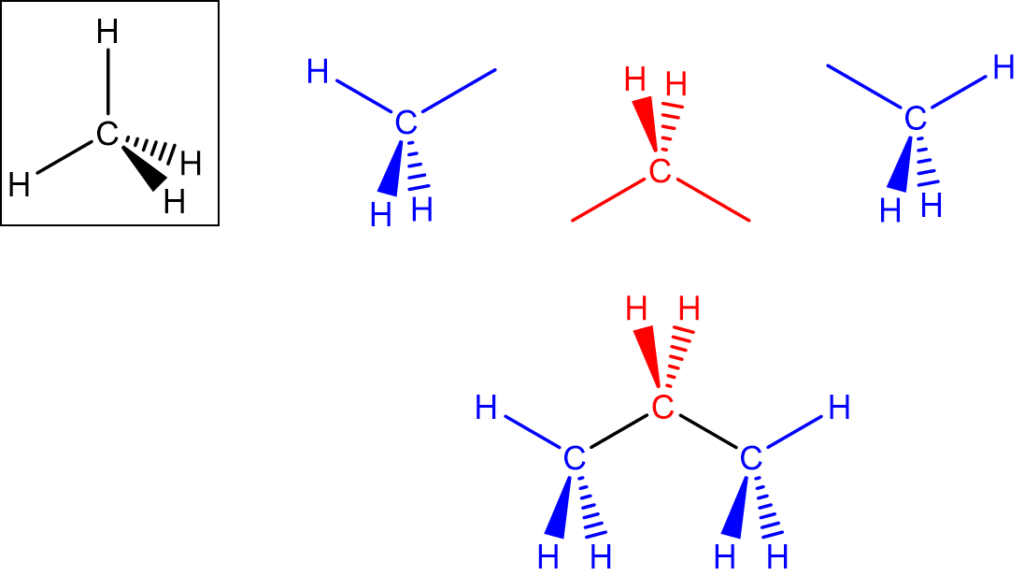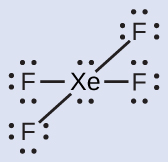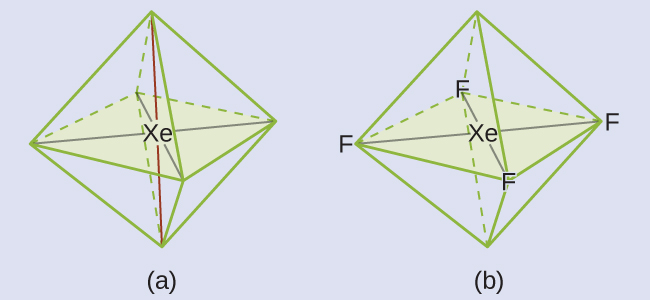The following procedure uses VSEPR theory to determine the electron pair geometries and the molecular structures:
- Write the Lewis structure of the molecule or polyatomic ion.
- Count the number of regions of electron density (lone pairs and bonds) around the central atom. Remember, a single, double, or triple bond counts as one region of electron density. This is because they connect the central atom to a single terminal atom.
- Identify the electron-pair geometry based on the number of regions of electron density: linear, trigonal planar, tetrahedral, trigonal bipyramidal, or octahedral.
- Use the number of lone pairs to determine the molecular structure/shape (see table on previous page). If more than one arrangement of lone pairs and chemical bonds is possible, choose the one that will minimize repulsions. Keep in mind that lone pairs occupy more space than multiple bonds, which occupy more space than single bonds. In trigonal bipyramidal arrangements, repulsion is minimized when every lone pair is in an equatorial position. In an octahedral arrangement with two lone pairs, repulsion is minimized when the lone pairs are on opposite sides of the central atom.
The following examples illustrate the use of VSEPR theory to predict the molecular structure of molecules or ions that have no lone pairs of electrons. In this case, the molecular structure is identical to the electron pair geometry.
Predicting Electron-pair Geometry and Molecular Structure: CO2 and BCl3
Predict the electron-pair geometry and molecular structure for each of the following:
(a) carbon dioxide, CO2, a molecule produced by the combustion of fossil fuels
(b) boron trichloride, BCl3, an important industrial chemical
Solution
(a) We can write the Lewis structure of CO2 as any of the five Lewis structures shown or variations on these since bond angles do not matter in a 2D Lewis structure, however angles and locations do matter in the 3D VSEPR structure and only one of the five drawings is correct for the VSEPR structure of this molecule:

Around the carbon atom, we have two regions of high electron density, as each double bond counts as one bonding domain (region). Using VSEPR theory, we predict that the two regions of electron density arrange themselves on opposite sides of the central atom with a bond angle of 180°. The C in CO2 has a linear electron-pair geometry and a linear molecular structure/shape. Both of these are the same since there are no lone pairs on the C atom.
Around the oxygen atoms, we have a different story though since we have lone pairs we the electron-pair geometry is not the same as the molecular shape. Both oxygen atoms have a double bond to carbon and two sets of lone pairs. This means each oxygen has three electron domains (3 regions of electron density). Using VSEPR theory, to put these three domains as far away from each other as possible we would have a trigonal planar electron-pair geometry. This arrangement results in angles of approximately 120° between each domain. We would NOT refer to this as a bond angle as with only one bonding domain the oxygen does not have a bond angle around it. Because no bond angle can be seen around the oxygens even though they have an electron-pair geometry they DO NOT have a molecular shape.
(b) We can write the Lewis structure of BCl3 as:

Thus we see that the B in BCl3 contains three bonds, and there are no lone pairs of electrons on boron. The arrangement of three regions of high electron density gives a trigonal planar electron-pair geometry. The B–Cl bonds lie in a plane with 120° angles between them. BCl3 also has a trigonal planar molecular shape.
There are three points that this above practice question is making:
1. the VSEPR geometry indicates the correct bond angles (120°), unlike the Lewis structure shown above.
2. ALL lone pairs should always be shown even on terminal atoms within both a Lewis and VSEPR structure. In the case of Cl, like above, the three lone pairs are drawn around the atom, without trying to show an angle of 109.5°. This angle is difficult to illustrate accurately without using wedges or hashes. Even if the three lone pairs are drawn with angles of 90°, it assumed to be 109.5°. This is similar to how angles were implied in the case of the water molecule.
3. Finally, in the practice question above you should realize that there is more than one possible orientation for a VSEPR structure. We can rotate a VSEPR structure in 3D space and it will still be correct, as long as we do not change the angle between the bonds. A model kit or a simulation can help one see the multiple orientations one can have of a single geometry. This is important when we have a larger molecule with more than one central atom. In such cases, it won’t always be possible to rotate each central atom into a single ideal orientation.
Take propane, CH3CH2CH3, as an example. We cannot have the same tetrahedral orientation for each atom. Instead, we need to rotate the tetrahedral atoms in order to bring them together to make the propane structure. Notice how the blue tetrahedral carbon atoms are in a different orientation to the red one. Additionally, both of these orientation differ from the methane (CH4) structure that was shown previously to the left.

The molecular shape simulator lets you build various molecules and practice naming their electron-pair geometries and molecular structures. On top of this it allows you to rotate the molecule to see how the same electron-pair geometry can have different orientations.
Using the molecular shape simulator allows us to control whether bond angles and/or lone pairs are displayed by checking or unchecking the boxes under “Options” on the right. We can also use the “Name” checkboxes at bottom-left to display or hide the electron pair geometry (called “electron geometry” in the simulator) and/or molecular structure (called “molecular shape” in the simulator).
It is recommended that you use your molecular kit or the simulation to help answer the following questions:
Two of the top 50 chemicals produced in the United States, ammonium nitrate and ammonium sulfate. Both of these, used as fertilizers, contain the ammonium ion. Predict the electron-pair geometry and molecular structure of the NH4+ cation
Solution (can a drop down option be created here so that the Lewis is hidden at first & the VSEPR below as well?).
We write the Lewis structure of NH4+ as:

With four bonds connecting the nitrogen atom to hydrogen atoms and no lone pairs, NH4+ has a specific arrangement. Consequently, the four regions of high electron density position themselves to point the corners of a tetrahedron, with the central nitrogen atom in the middle. Therefore, the electron-pair geometry of NH4+ is tetrahedral, and the molecular structure is also tetrahedral.

The ammonium ion, NH4+ is drawn in the exact same orientation as methane, CH4, shown above. As we said above, this isn’t the only possible orientation of a tetrahedral atom. Use the simulation or a model kit to help you with the following question.
Check Your Learning
Of all the noble gases, xenon is the most reactive, frequently reacting with elements such as oxygen and fluorine. Predict the electron-pair geometry and molecular structure of the XeF4 molecule.
Solution
The Lewis structure of XeF4 indicates six regions of high electron density around the xenon atom: two lone pairs and four bonds:

These six regions adopt an octahedral arrangement ((a) below), which is the electron-pair geometry. To minimize repulsions, the lone pairs should be on opposite sides of the central atom. The five atoms are all in the same plane and have a square planar molecular structure.

| What is your confidence level on this material after reading this section on VSEPR? Choose either Green (confident), Yellow (somewhat confident), Red (not confident). |
|---|